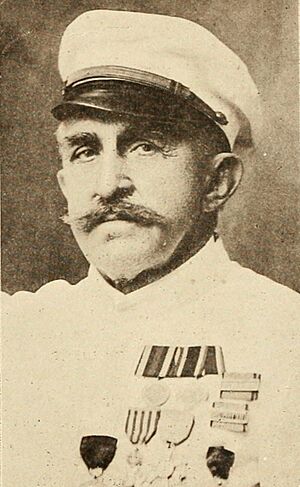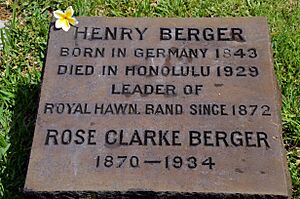Henri Berger facts for kids
Quick facts for kids
Henry Berger
|
|
|---|---|

Henry Berger c. 1917
|
|
| Background information | |
| Native name |
Heinrich Berger
|
| Birth name | Heinrich August Wilhelm Berger |
| Also known as | Henri Berger |
| Born | August 4, 1844 Berlin, Kingdom of Prussia |
| Died | October 14, 1929 (aged 85) Territory of Hawaii, US |
| Genres | Hawaiian, March |
| Occupation(s) | Bandmaster |
| Years active | 1872-1915 |
Henry Berger (born Heinrich August Wilhelm Berger) was a talented musician and composer. He was born in Berlin, Prussia (now part of Germany) in 1844. From 1872 to 1915, he was the royal bandmaster for the Kingdom of Hawaiʻi. He helped shape Hawaiian music as we know it today.
Contents
Early Life and Move to Hawaii
Henry Berger was born in Berlin, Germany. As a young man, he joined Germany's imperial army band. He even worked with the famous composer Johann Strauss, Jr..
In 1872, Kaiser Wilhelm I of Germany sent Berger to Hawaiʻi. He was loaned to King Kamehameha V to lead the king's band. Berger arrived in Honolulu in June 1872. He had just finished serving in the Franco-Prussian War.
In 1877, King Kalākaua made Berger the official leader of the Royal Hawaiian Band. Two years later, in 1879, Berger became a citizen of the Kingdom of Hawaiʻi.
Working with Hawaiian Royalty
Berger became good friends with Princess (and later Queen) Liliʻuokalani. She was also a composer. Berger helped arrange her songs for the brass band to play.
In 1881, King Kalākaua was traveling the world. He wrote a letter from Berlin to Queen Liliʻuokalani. He mentioned meeting Berger's mother and sister. The king also said he was sending a music program for Berger to play with the Royal Hawaiian Band.
Queen Liliʻuokalani later called Berger the "Father of Hawaiian Music." This shows how important his work was.
Developing Music in Hawaii
From 1893 to 1903, Berger worked with the Kamehameha Schools. He helped them create their music program. He also started what is now the Honolulu Symphony.
Berger led the government band at many public events. One special event was "steamer day." This was when a ship left the Honolulu docks. The band would play songs like "Auld Lang Syne" to say goodbye to the people leaving.
Preserving and Creating Hawaiian Music
Later in his career, Berger took on a very important task. He wrote down traditional Hawaiian hymns, chants, and other music. This helped make sure these songs would not be lost. No one had done this before.
At the same time, Berger composed many classic Hawaiian songs. Some of his famous pieces include:
- "The Hula March"
- "Hilo March"
- "Kohala March"
- "Huki March"
- "Ka Mo’i March"
- "Sweet Lei Lehua"
He also arranged "Hawaiʻi Ponoʻī." King Kalākaua wrote the words for this song to honor King Kamehameha. Berger's arrangement became the national anthem of Hawaiʻi. Today, it is the state anthem.
Berger mixed German, Austrian, and Hawaiian music styles in his unique songs. He performed with the Royal Hawaiian Band thousands of times. This helped make Hawaiian music famous around the world. Berger also started the "Aloha" welcome and farewell greetings at the harbors, played by the Royal Hawaiian Band.
Legacy
Henry Berger passed away in Honolulu in 1929. He is buried at the Kawaiahaʻo Church Cemetery.
The famous writer Robert Louis Stevenson even mentioned Berger in his novel The Bottle Imp.
Henry Berger's legacy is still celebrated today, especially in Hawaiʻi and Germany. He is known as the father of the Royal Hawaiian Band. This band is the oldest city band in the United States.


